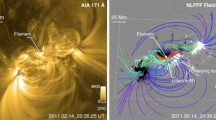Abstract
During the greater part of the 11-year sunspot cycle the solar corona represents largely a similar flat formation as in the minimum (looking like a galaxy), The observed variety of coronal forms is mainly due to variations of the corona's orientation as seen from the Earth. Two limiting cases of coronal orientation are discussed: perpendicular to the plane of the sky (‘edgewise’ towards the observer) and parallel with the plane of the sky. The first case is illustrated with the coronal observations of 11 July, 1991. The second case provides an opportunity to observe the corona from above the solar magnetic poles.
Similar content being viewed by others
References
Gulyaev, R.A. and Vanyarkha, N.Y.: 1992, Solar Phys.
Gulyaev, R.A. and Filippov, B.P.: 1992, Doklady Akademii Nauk 322, 268.
Hoeksema, J.T.: 1989, Adv. Space Res. 9, No, 4, 141.
Hoeksema, J.T.: 1991, Adv. Space Res. 11, No, 1, 15.
Author information
Authors and Affiliations
Rights and permissions
About this article
Cite this article
Gulyaev, R.A. The solar corona: Flat formation. Sol Phys 142, 213–216 (1992). https://doi.org/10.1007/BF00156645
Received:
Issue Date:
DOI: https://doi.org/10.1007/BF00156645




